Instead of packing our bags for what promised to be a magical National Council for Marketing and Public Relations conference next week in Orlando, our NCMPR colleagues coast to coast are grappling with the management of the global coronavirus pandemic. As the sole communication strategists and experts at their colleges, many of Interact’s clients and friends have been leading the way on their campuses to advocate for timely, responsive decision making and outreach that supports their colleges’ missions and the needs of their diverse communities.
Here are highlights of how some of them are mitigating risk, showing sensitivity and concern for the health and safety of their college community, and staying true to their brand promises in the midst of much uncertainty and angst. We at Interact applaud our community college marketing and public relations colleagues and hope that sharing these actions, insights, and best practices may provide helpful guidance to all as we continue navigating uncharted waters.
College Actions and Decisions
Many colleges are getting out ahead of the curve using the timing of spring break to increase social distancing and limit face-to-face content, while moving instruction to online delivery. This includes advancing the start of spring breaks, extending breaks an additional week or two, and moving to remote business practices upon return from break.
Spring break at Howard Community College in Maryland, for example, was scheduled for April 6-12. In response to state and local county guidelines recently announced, the college moved up their break to March 16-22 and canceled classes for the following week of March 23-29. Nearby, on March 13th, the Community College of Baltimore County had canceled classes March 16-22, planning to remain open with on-campus services. The college has since decided to shut down this week and to move up its spring break to begin March 23rd. The college is also training faculty for remote instruction, which will begin March 30th.
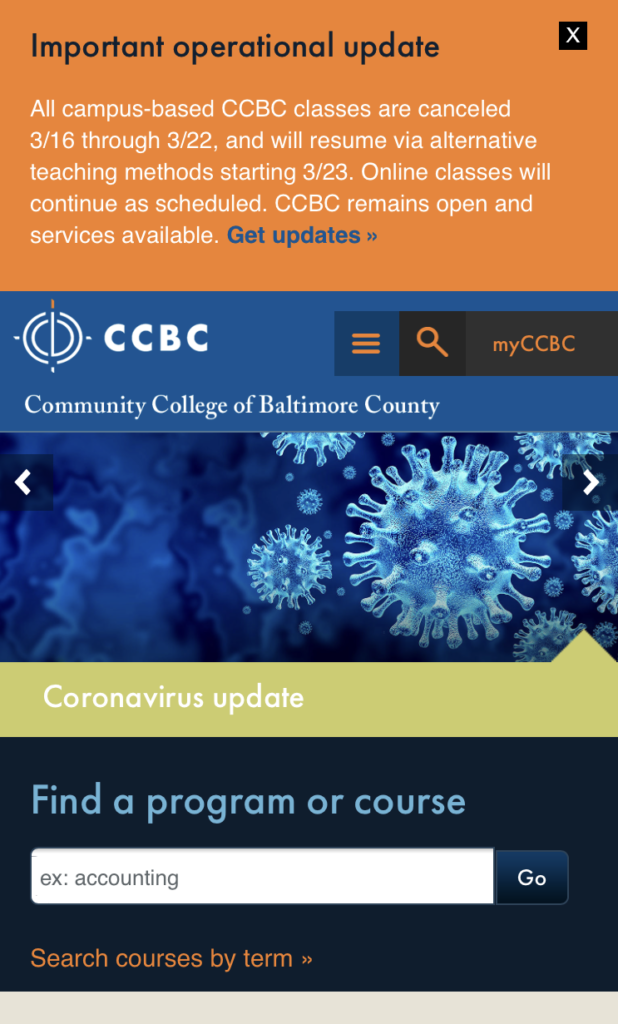
Irvine Valley College, in the South Orange County Community College District, has implemented a “soft close” following their spring break the week of March 16-20. During this soft close from March 23 through May 1, the college will hold lecture instruction and some labs online. The college is also extending online tutoring, counseling, and other support services, while continuing in-person hands-on labs, studio instruction, and support services such as the Health and Wellness Center.
South Texas College (STC) in McAllen, Texas is extending its spring break one additional week and will then resume face-to-face classes. The college is not only communicating the closure to its students and community, but is also focusing resources on ensuring that students will be set up for success should classes need to move online.
“Not all students are prepared to succeed in an online environment,” said Daniel Ramirez, South Texas College’s director of public relations and marketing. “There are different learning styles, not to mention that not all of our students have access to computers or Wi-Fi. We don’t want to create more burdens for them during an already stressful time and have decided to focus attention on providing tools and resources that will help them succeed.”
All colleges are focusing on media relations efforts and using the news media to communicate important information about the virus and how it is affecting their college communities. Grossmont College, in San Diego County, California, also dealt with an unfortunate posting on a fake online news site that claimed a student at the college tested positive for the virus. Rumors circulated that the school was shutting down. The college’s communications and public information director, Anne Krueger, took swift action in communicating to the public that the information was false.
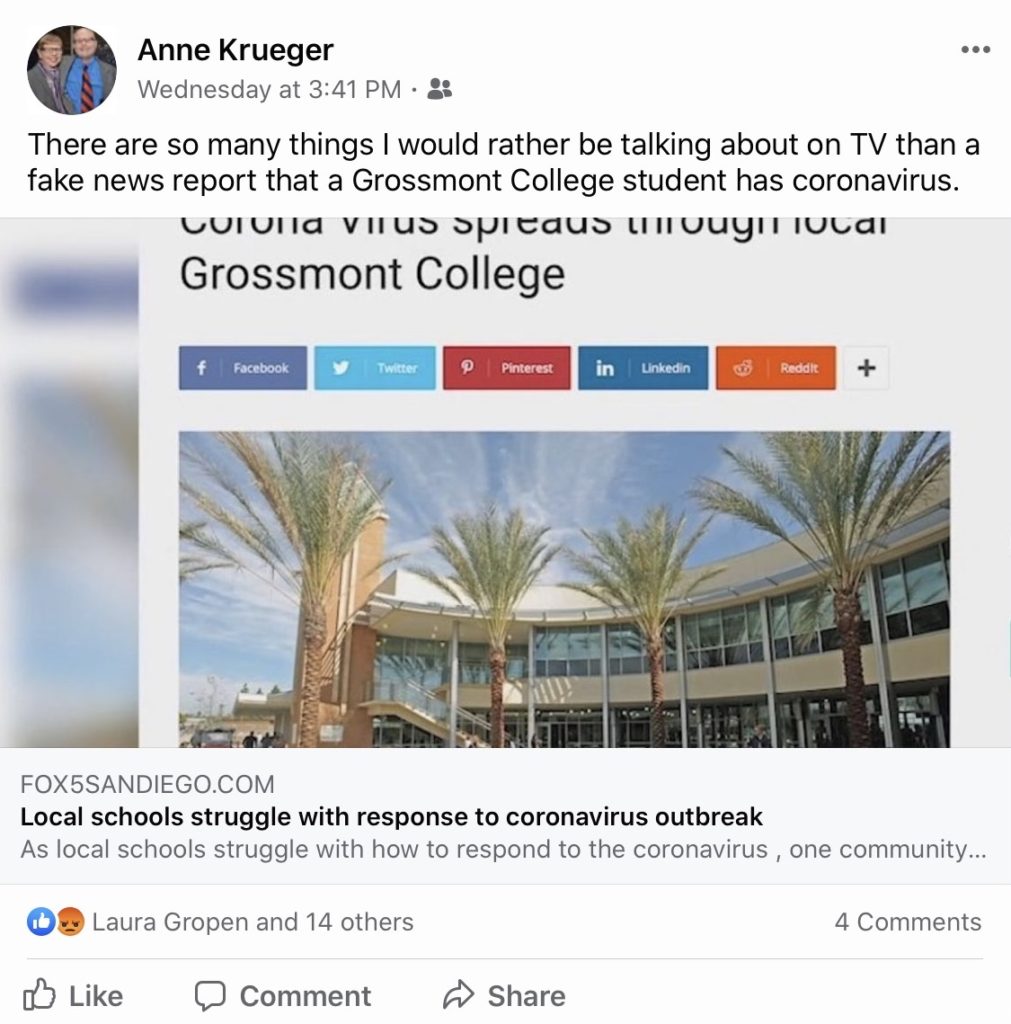
“You have to be proactive,” said Krueger. “Monitor the news media, the Internet, and social media for mentions of your college and make sure you have a swift response.”
Communication Best Practices
Here are six best practices two-year colleges are employing that could help you share information broadly and in ways you can readily update:
1. Create a dedicated landing page.
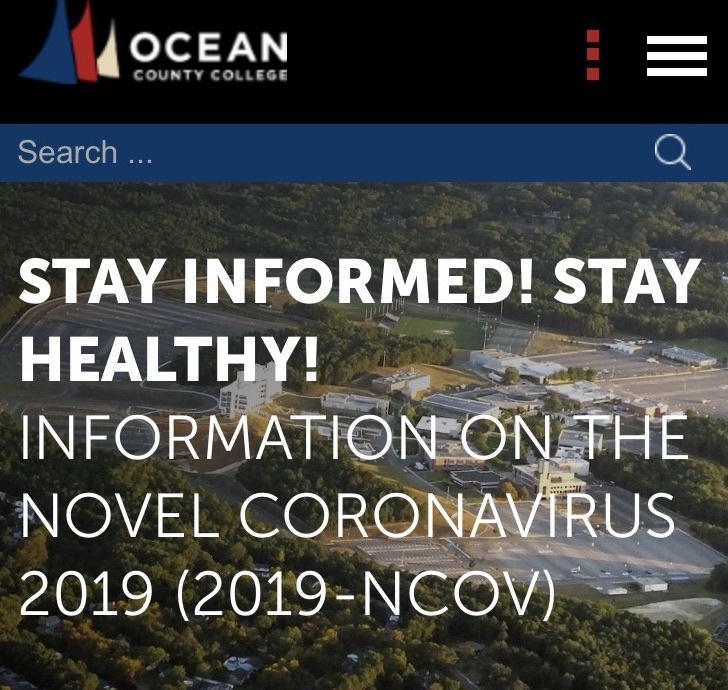
Driving everyone to this dedicated page will enable you to deliver and maintain a clear, consistent message, which is vital during a crisis. You can update this page quickly as you have news and additional details to share. Best of all, you can link to it from every other mode of communication you use. And don’t forget to use your homepage to drive people there via homepage alert crawlers and carousel display ads.
2. Publish FAQs.
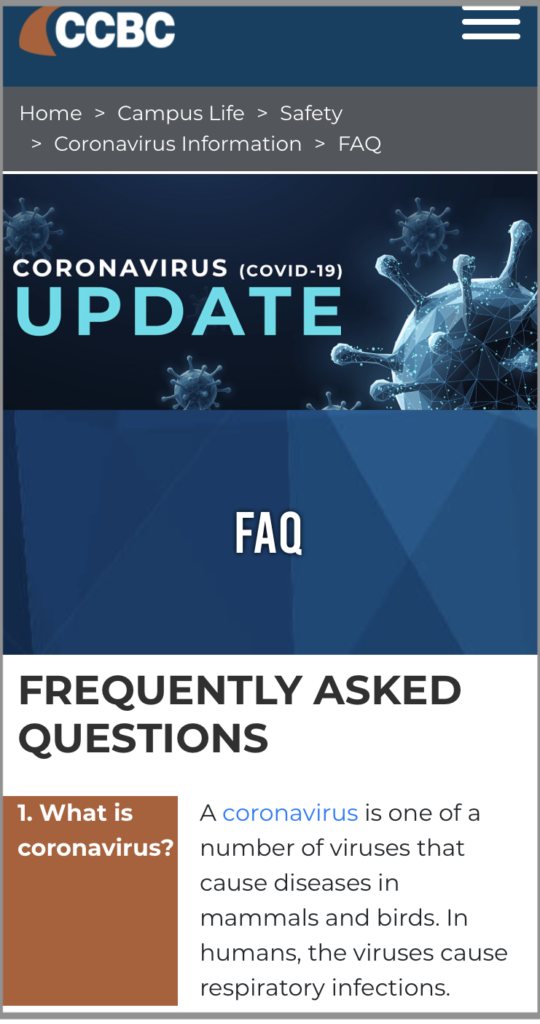
FAQs provide a helpful, succinct way to focus on and share key messages. With everyone being inundated with 24/7 coronavirus news, students may feel overwhelmed and need your help to focus on the most critical information impacting their ability to complete coursework and address both academic and non-academic concerns. Use FAQs to provide them answers to what you know weighs most heavily on their minds and connect them to the resources they need. And don’t forget about your non-credit students, dual credit students and parents, and community members who attend your events and use your facilities.
3. Establish a hotline.
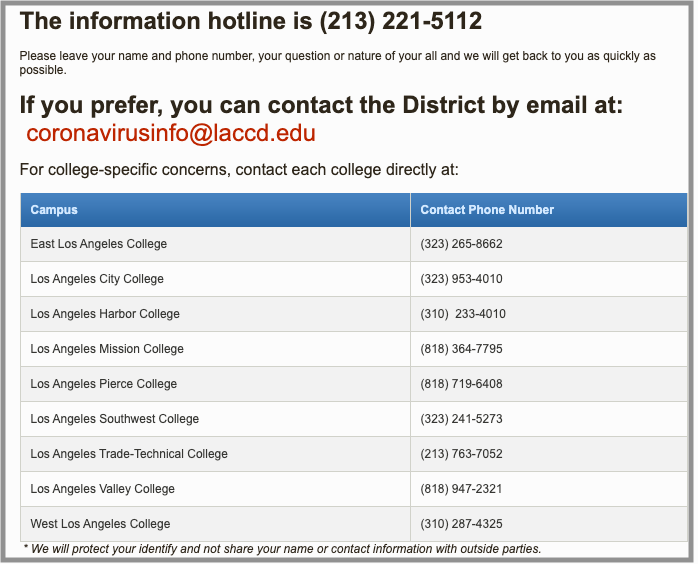
Set up a dedicated phone number like the Los Angeles Community College District has done to readily address questions and concerns. This is especially helpful when students are feeling anxious. If you cannot staff it appropriately for 24/7 response, at the very least, establish protocol for maintaining a timely response to all messages left. That doesn’t mean later in the week. It means within the hour, if possible, but at least before the end of the day.
4. Keep a multi-media perspective.
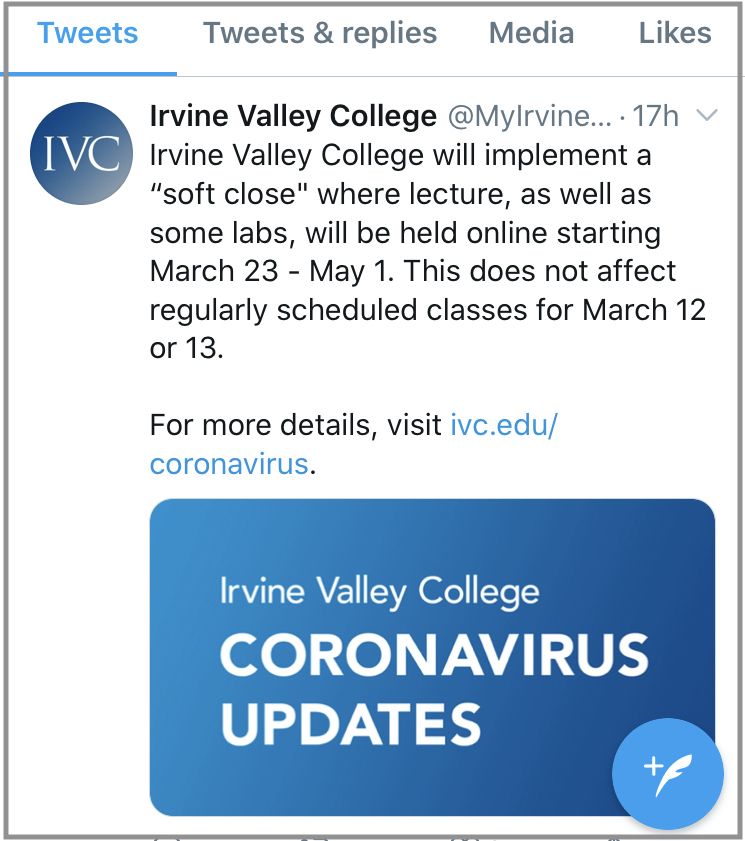
Use an integrated, multi-media approach when considering how to reach your diverse audiences. Your online newsroom is an opportunity to not only publish the latest news regarding closings and alternative course delivery, but also to feature links to helpful videos, college blogs, and social media to connect your community when they are no longer in physical proximity.
Maintain a 24/7 eye on social media and college app activity, as students expect immediate responses. If you do not have a dedicated social media team, figure out a “divide and conquer” strategy by tapping people across your department and in partner areas of the college, like admissions and student life, who can best assist you in timely responses.
Don’t forget about college email and texts. Students check their college email, especially during times of crisis. We know this from Interact’s Media Prefs data. They also appreciate texts when you’re providing time-sensitive information impacting their schedule. Make use of these channels to not only keep your students informed but to connect them to helpful resources for academic and non-academic support. Keep your messaging short and mobile friendly. Provide warmth and levity where you can and link them back to your landing page for details.
As Daniel Ramirez reminds us, “It’s easy to lose sight of the human element when communicating crisis messages. That’s why it’s so important that we as a college assure our students that we are here for them and give them the resources that will help them take care of themselves and reach their goals.”
5. Don’t forget about your employees.

On Friday, nearly every K-12 school in San Diego county announced that it would close for anywhere from one to six weeks. This meant that colleges, who themselves had moved to online instruction for students, were faced to take action about whether or not employees could be allowed to work remotely.
“We have a lot of working parents, and single parents,” said Anne Krueger, director of communications and public information. “We don’t have a robust work-from-home policy and had to jump into talking about how we could make this work for employees. Do they need to take vacation time? Sick time? What about our janitors or people who work on certain computer systems that are protected and only available on campus?”
Questions like these can take a long time to sort through and answer. Encourage your administration to be proactive and begin discussions on what will happen to employees should the entire campus have to close.
6. Lean on one another.

You are the only ones doing what you do at your college. But you have a network of community college communication experts who understand what you are going through and are ready to support you. Think about the connections you have through your statewide coalitions, professional organizations like NCMPR, and partner agencies like Interact. Reach out to them. Here are some words of wisdom from your colleagues also on the front lines of this war against the coronavirus:
“My best advice is to prepare first, then to communicate. Also, know that it’s changing day-by-day and hour-by-hour, so you have to remain ready to mold and adapt your communications constantly.”
Leslie Tennant, Director, Marketing, Community Relations and Advancement, Community College of Beaver County, PA
“At Saddleback, we started communicating early with students. Updates
from our college president were regularly sent to both students and employees
to provide assurance that their health and safety are our priority, and that we
are closely monitoring information from public health agencies. It also
allowed us to strongly advise students against foreign travel and travel to
counties with community-acquired COVID-19 cases, and to let students know about
the measures we’ve taken on campus (including an increased priority of our
facilities and maintenance crew to clean common areas). We have emphasized
that any decisions about campus operations would be based on data, science, and
expertise, not fear.
Now that we’ve made a decision to move classes online, we’re working on
communications that will be delivered next week regarding available services,
how students can acquire laptops and other devices, and other operational
issues.”
Jennie McCue, Director of Marketing and Communications, Saddleback College, CA
“What I think is pretty cool is how our students are triaging each other. We see them doing that on our college app. They’re resilient.”
Jan Kirsten, Executive Director, College Relations, Ocean County College, NJ
Interact is here to help. Let us know if we can assist you in preparing any of these communications and to guide you through any situation where you may need extended support. Just reach out to us at info@interactcom.com.

Links to college coronavirus information featured in this blog:
Los Angeles Community College District
Ocean County College
Community College of Beaver County
Community College of Baltimore County
Irvine Valley College
Howard Community College
South Texas College
Saddleback College
Grossmont College
One more thing…
Other colleges have created “keep learning” pages, including Virginia Commonwealth University (https://altlab.vcu.edu/rapid-response/students/). These pages provide quick links to tutorials about how to use various online learning platforms, resources for mental health support, and even ways students who don’t have computers can purchase or rent them.



